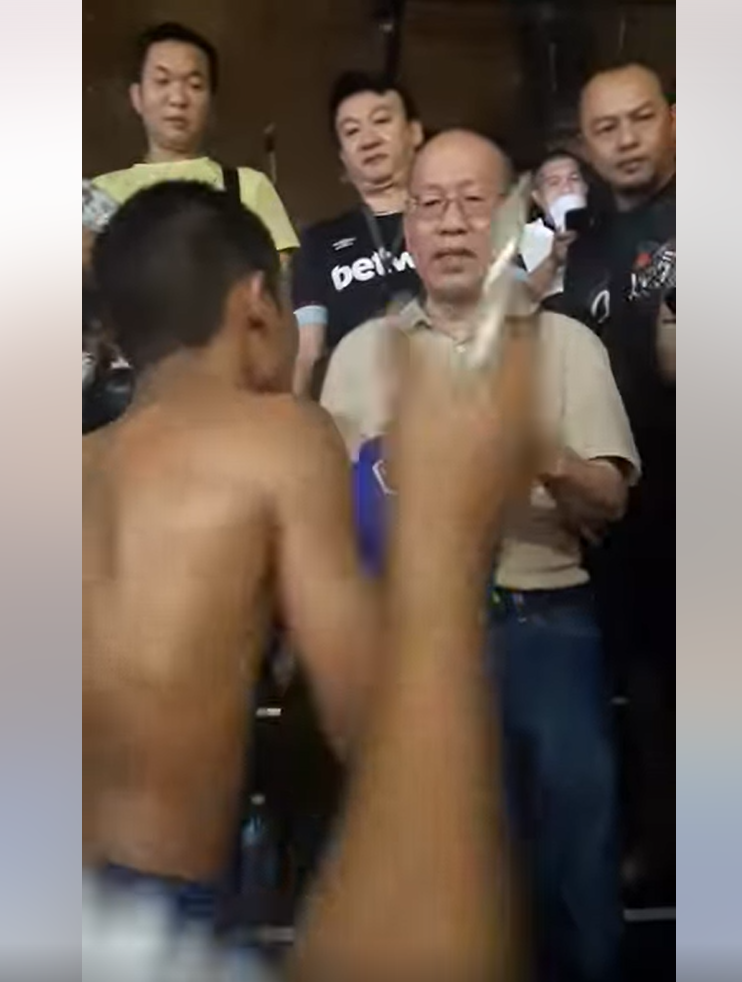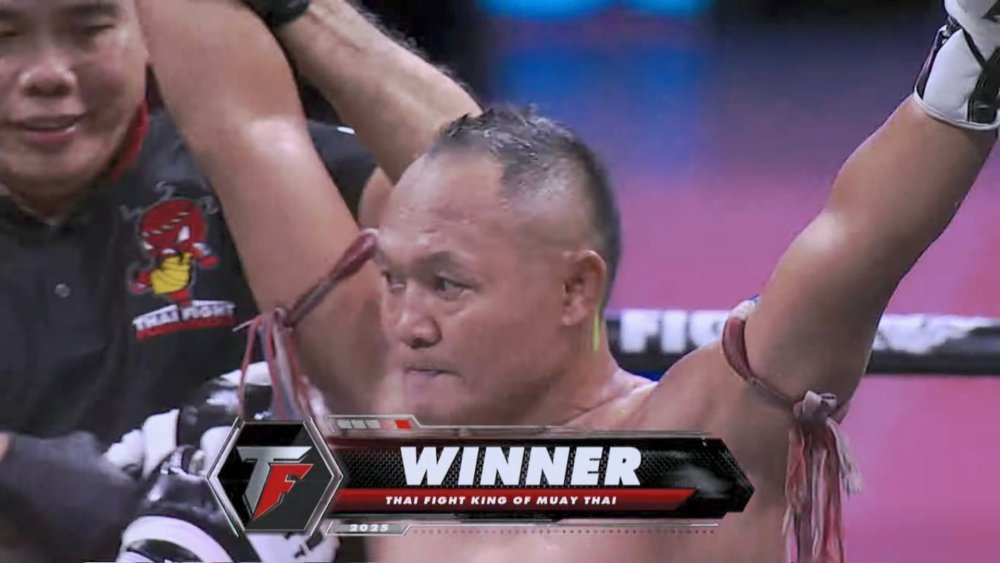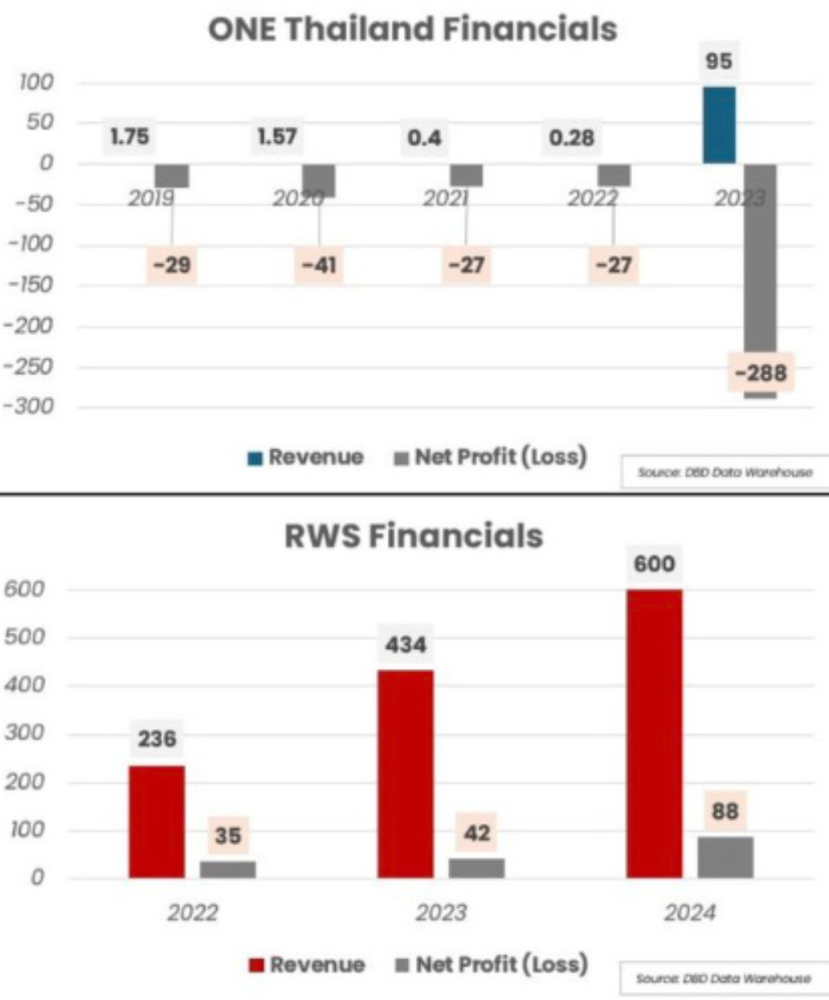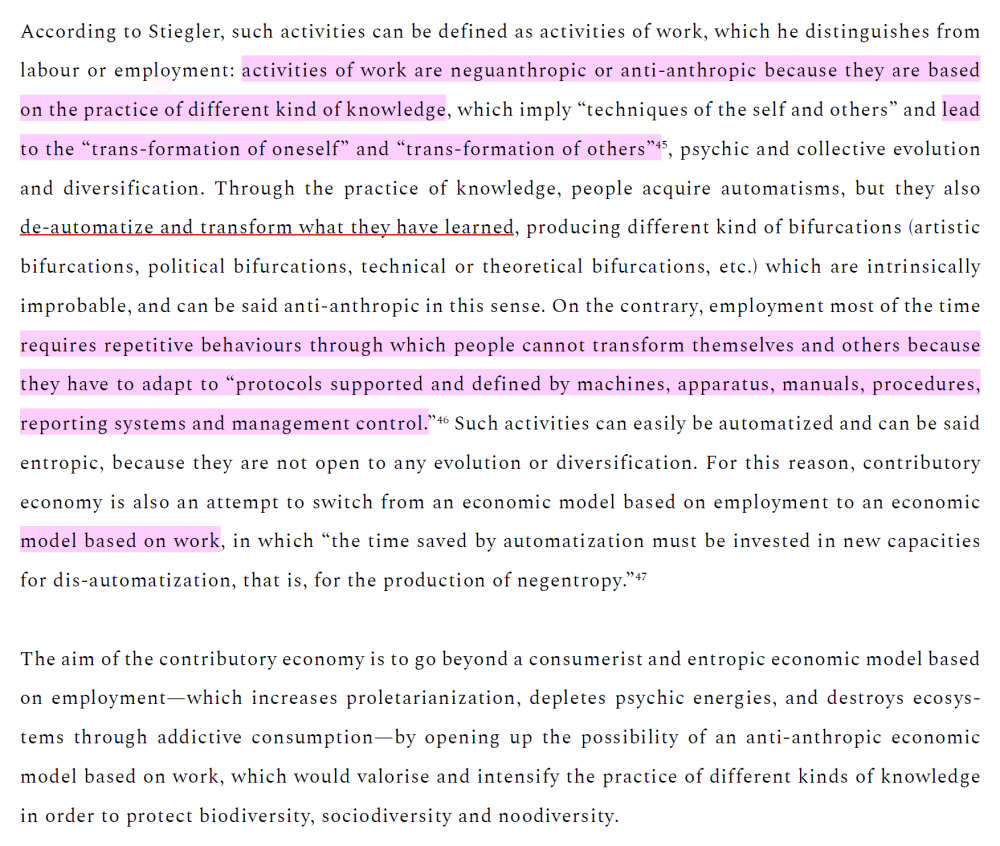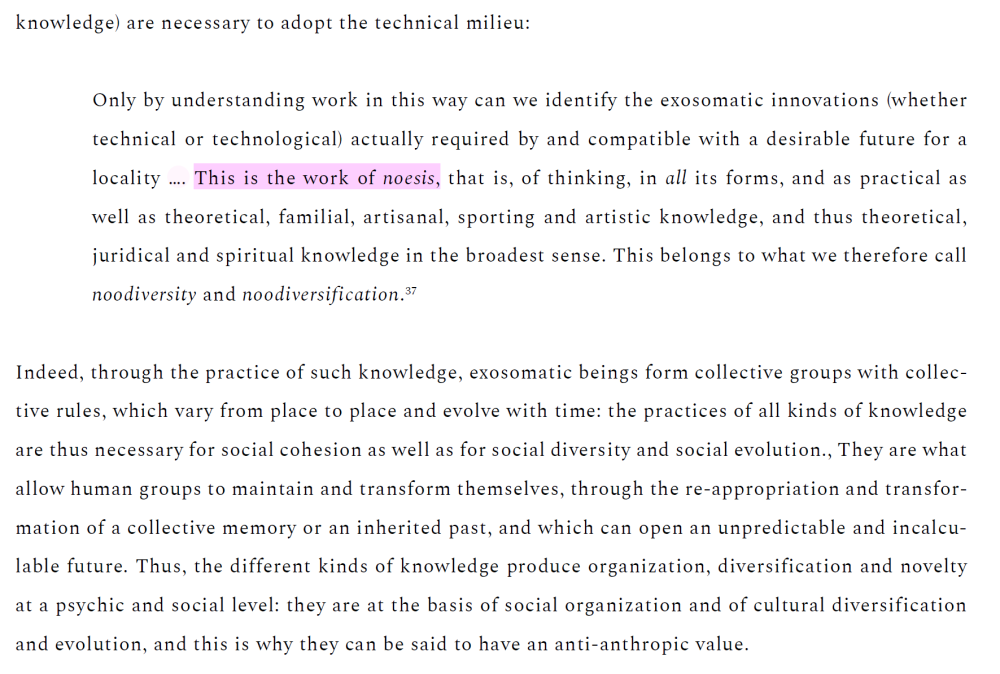All Activity
- Past hour
-
Kevin von Duuglas-Ittu started following All of Wichannoi Porntawee's Fights With Notes
-
Wichannoi Porntawee is a fighter like no other in the history of Thailand's Muay Thai. While many in Anglophone Muay Thai conversations had hardly heard of him legends after legends put him at the top of their picks for the greatest Muay Thai fighters in history. He fought with a very boxing based, combination heavy foundation at close range, but had a highly developed style for controlling all ranges, often facing powerful fighters much bigger than himself. He was nicknamed The Immortal Yodmuay (legendary nakmuay), and Dieselinoi, himself a GOAT candidate called him "my teacher in the ring", Wichannoi the man who stopped Dieselnoi's 20+ fight win streak and meteoric rise to stardom, with back to back wins against the much taller fighter. Watching his fights one night, one after the other, all 11 which exist was an extraordinary experience, I think the most intense and education video watching experience I've had in my study of the art and sport. Below are my watching notes and each of the fights in chronological order: vs Pudpadnoi 1 of 3 (1971-12-17) - southpaw, win a very femeu fight vs one of the great femeu fighters in history. Lots of quick low kicks and pivots, lots of positioning. Then in the 4th Wichannoi uncorks a quick 2 punch combo that lays Pudpadnoi out. The only time Wichannoi would beat Pudpadnoi in their 3 match ups. the fight: Huasai Sitthiboonlert (139 lbs, 1973-06-22) - orthodox, win fight waaay up, you can see the visible size difference. Early Wichannoi is just picking at the legs. Huasai look like a ponderous boxer with power. Huasai starts bringing the fight to him, a deep pivot out by Huasai puts him against the ropes. Wichannoi measures and puts him out with a powerful right hand just as Huasai opens up to punch, and even rips an elbow or a tight hook, just missing the falling Huasai. Huasai looks done laying their motionless, and then suddenly springs up energetically to life. Wichannoi pressures and pounces, never snuffing his punches, always liquid in range, landing combinations and putting Huasai down again. He's up again on the count the giant who cannot be killed. Wichannoi catches him on a dive out next, landing a hook and declared the winner with 3 knockdowns in the round. Does several summersaults in celebration. vs Sirimonkol 2 of 2 (134 lbs vs 136 lbs, 1973-10-26) - southpaw, loss giving up two pounds vs a the future FOTY (1973), a legend of the sport. Early on big weapons are out. Sirimongkok is openside southpaw kick blasting and throwing his straight, Wichannoi knocks him down (no count) with a right straight of his own. Sirimongkol's big kick and boxing keep Wichannoi waiting, and he even rips a kickout trip on Wichannoi. He has more weapons with force. Against the added size Wichannoi can't intimidate with his own power. 3rd round Wichannoi has decided to chop the lead leg down, a favorite against southpaw. Quick inside and outside kicks. Sirimongkok adjust, keeping things long, and teeping with his lead leg to avoid it being excessively targeted. Wichannoi heats up his boxing combinations closing the space, but Sirimongkol has boxing himself, and keeps it long with jabs, slipping Wichannoi's best punches, jabbing and pivoting out. He also answers Wichannoi's tough leg kicks with powerful leg kicks of his own, giving him game to game. 4th round you can just feel that Wichannoi wants to land powerful hand combinations, and he's holding them in wait, only throwing them occasionally. Sirimongkol is still keeping it long with his boxing and a few openside kicks, its mostly about distance. He's also added a left knee in space this round, which is a weapon tailored to beat a boxer. Sirimongkol uses his size and maybe even strength advantage to just deal back Wichannoi whatever he offers, even winning at trading punches. Again, game on game. Wichannoi just can't get to his sweetspot with his hands, and even when he does Sirimongkol just fights him out of it. 5th round Wichannoi is just determined to get to his spot and stay there. He pressures and buckles Sirimongkol some with low kicks. Sirimongkol is doing everything to get him off his spot. Jabbing out, trading low kick for low kick, Wichannoi is staying where he needs and is waiting for his big punch to land. The battle of distance and Wichannoi finally planting his flag is what this fight is about. Sirimongkol finally grabs him to stall it out, but after the break Wichannoi lands a painful low kick and a heavy cross. Sirimongkol grabs to stall, but then shoves off. Wichannoi wades in with pseudo clinch, and then kicks out Sirimongkol's ankle dropping him to the ground. Wichannoi is bringing his legendary toughness, he feels he has a window late. He's trying to kill that leg, staying in. Sirimonkol's deep boxing pivots to the left save him. Wichannoi started too late, and in the end Sirimongkol's size and boxing was enough. vs Saensak Muangsurin 3 of 3 (1974-08-22) - southpaw, loss Fighting way up vs the 140 lb Lumpinee champion. This fight is a difficult and indeed dangerous fight stylistically. Saensak's known for just sitting on his huge left hand. He has tremendous power. Wichannoi likes to encroach with kicks, eventually stand in and keep his right hand there loaded with power...but he almost always throws his right in combinations. To sit in the pocket though, while Saensak who is two weight classes bigger trains his .44 magnam at him is just asking for pain, and Wichannoi starts this fight tentatively at distance, holding his right glove like a trainers mitt. It's purely devoided to defense. There is some hand fighting as Saensak's .44 is pointed at Wichannoi's smaller caliber with a kick, Saensak crashes in with a straight and its a lot. Wichannoi shifts at the angles, pings at the legs, but its very unclear what he can do. That big left is staring at him. He lands an off-rhythm staight, no combination, and it does nothing. In the 2nd round Saensak realizes that he has control over both range and power and fights passively, backing up, just letting his left wait for Wichannoi to come in. He has to come in, there is no way else to win this fight. Wichannoi starts bouncing around to bring rhythm, this is kind of one of his triggers, and Saensak follows him in it, bringing more life to his own feet. Saensak has long, slow openside kicks that land because Wichannoi is seriously worried about that left. His lead growing. 3rd round Wichannoi has turned the knuckles of his right hand a little bit more forward, its no longer just a trainer's mitt. He's creeping in as he likes to do, usually he wants to plant that flag and punish with lowkicks, but Saensak is beast and even his misses are frightening. Wichannoi tries with lead hand to hand pressure with then his right, or a short body kick. Somehow he needs to get to his spot, he's standing in. Saensak throws an absolutely blazingly fast 2-5-2 combination where the first 2 isn't even a complete punch. It's just a jesture which opens up the guard, the 5 and the next 2 knocking Wichannoi out. wow. Saensak doesn't throw a lot of combinations but this one is just incredibly fast and accurate, and it delivers the left hand bomb. Because Wichannoi is so wary of that left hand that 2 to start just opens him up. He walked into the exact buzzsaw he feared, but some craft with it. They fought 3x, Wichannoi had beaten him 2 years before (I can't imagine how). Saensak: King's Fighter of the Year in 1973, WBC World Boxing Champion vs Pudpadnoi 3 of 3 (1976-05-27) - southpaw, loss the fight starts out with a bit of range-finding but it becomes clear that the range that Wichannoi is looking for his Muay Maat punching range. He's pressuring, differently than in fight 1. Lots of powerful (rather than flicking) lowkicks early. Round 4 Wichannoi's power kicking game is turned up. Not only kicks to the legs but also to the open side, always measuring for a big right hand. Pudpadnoi is just slippery enough and lands two big kicks with his famous left leg, but Wichannoi had him flinching on low kicks too. He couldn't land his right though. In the 5th Wichannoi still kicking but you can feel he wants to land his heavy hands, the fight is staked on it. He is waiting, but the Golden Leg of Pudpadnoi holds the fort. vs Jocky (1976-08-18) - orthodox, win a marvelous 3rd round of boxing up a Muay Khao dern fighter, using lots of jab and pivot, jabs to the body to just piece him up with his hands. Jocky adjusts and derns leading with his teep in the 4th round, trying to bring his clinch back online, and this seems to work, ending Wichannoi's boxing. But Wichannoi already has a substantial lead at that point. Wichannoi coasts to a win vs a renown knee fighter. https://www.youtube.com/watch?v=6OxxQLX2NQM
- Today
-
In thinking about Muay Thai training techniques, and the deploy of techniques in fighting, I always turn to a chess analogy. There are "bad" moves one can make against mediocre players, that are in fact "good" moves in terms of results. But, it feels questionable to learn and train "bad" moves of this kind, not only because you might run into a strong player - you might, or you might not - but also because when you learn bad moves, and don't see "why" they are bad or weak, you just don't understand the game at a necessary level. The whole point of looking at moves and thinking about this is understanding the underlying principles that make moves (or tactics, or strategies) good or bad, so that in thinking at that level, you can creatively and spontaneously create novel moves for a given situation. There is an interesting sub-example of this floating out there, the "don't turn your lead foot on a hook in Muay Thai because you'll get kicked". There are layers to this idea. The first is the idea that "sure, you can get away with this against a poor opponent, but if you fight a good one, you'll get kicked". Sounds good, sound penetrating, along the lines which are above. But, not the case. There are any number of ways that this isn't really a readymade practical danger, no matter the skill quality of an opponent. Strikes always exposed oneself to counters. The efficacy or dangers of strikes relies very heavily on set up and situation. What is your range? What comes before and after? A 100 questions that matter. There isn't really just a "if you do x, y will happen", and a lot of the discussion of techniques falls into this error. You can't boxing slip or you'll get kneed. You can't body punch or you'll get elbowed. There are always trade-offs, and its important to see potential weaknesses, but honestly getting calf kicked with a turned foot (which isn't likely to happen at the right distance in most effective hook throwing scenarios) isn't that much different than getting your calf kicked without your foot being turned, in fact if you are weight transferring to your back foot its probably not a major problem...and if its a problem, you adjust. Is your foot outside the stance of your opponent? How far are you, what is the distance? Are you proximate enough? What did you just throw? What are the trade-offs? Inotherwords you need to look at all the pieces on the board. Instead you just get meme'd wisdom. If you do x, y will happen. This is the layering of the chess analogy. This is when we think about the larger picture, the larger principles. In some cases turning your foot may not be optimal, but in others it may give you several trade-off advantages. Some of this goes to the philosophy of the hook itself, why you are using it and how are you generating power? In general though, its worthy to move past the "it works it must be good!" assumption, because there may be larger principle reasons why it will not work against a better opponent, or, the success of the technique may mislead you into thinking a whole class of approaches are fundamentally sound. But, on another level, any question of soundness because of reason "x" also has to be put in larger context of how it matters how a strike is executed, how strikes work in concert, and the trade-offs of offense and defense.
-
kkadzielna started following Muay thai in Australia
-
You won't find thai style camps in Europe, because very few people can actually fight full time, especially in muay thai. As a pro you just train at a regular gym, mornings and evenings, sometimes daytime if you don't have a job or one that allows it. Best you can hope for is a gym with pro fighters in it and maybe some structured invite-only fighters classes. Even that is a big ask, most of Europe is gonna be k1 rather than muay thai. A lot of gyms claim to offer muay thai, but in reality only teach kickboxing. I think Sweden has some muay thai gyms and shows, but it seems to be an exception. I'm interested in finding a high-level muay thai gym in Europe myself, I want to go back, but it seems to me that for as long as I want to fight I'm stuck in the UK, unless I switch to k1 or MMA which I don't want to do.
-
Because I've mostly studied the Golden Age of Muay Thai and after I'm often of the opinion that "Muay Thai doesn't have combinations"...and this is often true. The use of punches are much more vision driven and creative, and at times very good boxers like Somrak won't even be throwing punches, but will be using boxing's footwork or angle taking. But...if you go back to the 1970s many Muay Thai fighters did use boxing combinations to great effect, perhaps no fighter more than the great Wichannoi who punches with speed and power along a grammar of combination fighting. In fact after watching all his fights last night I think one could say that his entire style is organized around his close range combination Muay Maat attack. It's very clear how important they are to him. Last night I also put this brief edit of a 2-5-2 knockout combination that Saensak used to knockout Wichannoi, which is just electric. It really works because Saensak has a thunderous left that Wichannoi is very wary of and has to commit to shut down. But, in the story of boxing's influence on Thailand's Muay Thai that goes back to at least the 1920s, it does seem that there was a qualitative change between the 1970s, then the 1980s, then the 1990s. It's almost as if Western Boxing was digested by Muay Thai, and its influence became more and more diffused, affecting more and more elements, but also less standing out stylistically through combinations. Golden Age punching styles took on their own unique character, through a widespread integration. One of the interesting things is that because Thailand is becoming combination oriented in its training, with the influence of Westerners and the rise of Entertainment Muay Thai, the Silver Age with its much more distinct combination fighting may be a better touchstone than Golden Age excellence. And Wichannoi in particular perhaps.
- Yesterday
-
Geez. I spent the whole night watching all 11 of the existing fights of Wichannoi Pontawee, who many legends named as the GOAT. I've watched his fights before and have enjoyed them, and a few times wowed, but I felt like he's just too important a fighter to be only "somewhat" familiar with him. I had crisp idea of how he fought, and I saw him have some spectacular moments. But its an entire different thing to sit down and watch all the fights - taking lots of notes - back to back, one after another. I don't think I've learned as much watching any other fighter. It's remarkable. Hopefully I can put these notes together for others.
-
Selvinion joined the community
-
Gloves for a beginner
Goldish posted a topic in Muay Thai Technique, Training and Fighting Questions
Hi, I just started Muay Thai and I want a pair of gloves that will last me more than a year and I could use as a all around glove for training and also sparring for when I like rank up. I am 250 lb, 6'1 so I am a bigger guy and I was thinking getting the Twins Special BGVL3 16 oz gloves? Are these good for what I want or are there better options for a similar/cheaper price? -
Malinka started following Mouthguards - What Kind Do You Use?
-
Malinka joined the community
-
callenvox joined the community
- Last week
-
One of the effects of deteriorating defense in Muay Thai is that sub-optimal offenses will become more effective. Which is to say, they will no longer appear sub-optimal (based on flawed principles). The lack of eyes, or distance control, or sound principles on defense will elevate certain offensive trends which would never fly in the past...one of the subtle ways deskilling is happening. Basic combo-ing sudden is proven effective. Blind pocket trading, effective. Spamming elbows, effective. And with that effectiveness the loss of skill.
-
One of the great ethical difficulties to the above is: Do you want to make visible what is currently invisible to the cartographic appropriations of colonial capital? Or, just let them sit safely out of range, in their unseen character? On one hand it feels like you must make them visible so to marshall forces to protect and safeguard, and even possibly restore; on the other hand by mapping the invisible then you just set the conditions for appropriation and distortion, and eventual elimination. One of the aspects which I believe kept Thailand's Muay Thai so resilient, despite so many international influences (probably for 500 years even), is a certain kind of hermetic quality to provincial Siam/Thailand, the way that there are cultural dividing lines, which provincial ways of life and culture exist in their own right, than you are passing into another "land".
-
This is an English translation of a Facebook post written in Thai by a prominent figure of Southern Muay Thai, protesting the new government and stadium changes brought to make Muay Thai more amenable to foreigners. A lot of truth here in how the knowledge of the sport actually lays within the villages and at the festival level...some of this language is quite strong though, far beyond Thai etiquette. Just posting it here because many don't realize that there are Thais that firmly resist these changes, and see them as undermining the sport and art itself: "I have been in Muay Thai my whole life. I've been in it before it became corporate. I've stayed in it with love for the sport. Muay Thai is a poor people's sport. Only children of poor families will fight. In the past, this was a "mafia" sport. Hence, no organization wants to get involved. However, this sport still does things the countryside way. Fights relies on temple fairs and annual events. Rules and regulations that are used were made by the people who of Muay Thai who truly understands it. For example; the 5 rounds, 3 minutes per round and 2 minutes break, weigh-in in the morning. It's all made for fairness, even if the bigger fighter will gain an advantage if the fight is at night time, because morning weigh-ins will impact a fighter's management. In the current day, rules are about to change, because the organizations responsible for Muay Thai do not understand the life of the people of Muay Thai. They don't understand fighting in the Muay Thai way. They attempt to compare Muay Thai with the foreigner's martial arts. They try to shove foreigner's rules on to the roots of our sport and tell us it is universal. They are trying to change our way of life by washing away our Thai identity with their papers and regulations. They bring specialists who've never made any contact with the sport to write the rules without asking of what the people who will be following these rules and bequest the national arts think about the rules. This is borderline of selling the country, selling it's traditions, selling your own roots, just to impress foreigners. The spirits of the ancestors will call you damned children."
-
Been pondering a new style gym, but one radically different than what Thailand knows. Something of a studio. And even a profit sharing concept...but I suspect that Sylvie will never let me do this, as she really doesn't want anything to do with having or running a gym. But, it may not be what she thinks. It's a space like some spaces, many moments really, we have experienced in Thailand, where "Muay Thai happens". It's not practiced, its not done. It "happens". There could be an environment like this, which is not lost to the restrictive difficulties of the past, or the vast commercializations that are coming. This would necessarily not be a "successful" gym. In fact it would be structurally against any such possibility. Much more like an experiment in Muay Thai thought, a small island...which then might echo out and influence other spaces, spaces we are not really interested in. #idea
-
Aseitic joined the community
-
This will be one of the significant challenges of trad Thai fighters going forward. They are increasingly not within the discipline and authority of the kaimuay system which developed them when young (socio-economic changes are creating a new autonomy and a cross-mix of progressive motivations) and Thailand's Muay Thai is being bent toward Western style weight cutting with new weigh-in processes. The Science of weight cutting of the trad kaimuay is made for the trad fighting system, and of the kaimuay subculture. As those disciplines become loosened they will find the new world of weight cutting competition quite difficult. There will be a lot of missed weights in the New Muay Thai that is coming. I don't know about his particular situation, but it does provoke these thoughts I've had about an increasing trend. Thais in trad Muay Thai really seldom missed weight by custom. Trad fighters near the top of the sport are going to be caught between (non-rigorously applied) Thai cutting practices, Western cutting practice suggestions (a bad combination because Thai & Western cutting is very different), amid bigger weight cutting demands. They'll find themselves chasing down big cuts late (or just deciding not to make weight like Superlek vs Rodtang), which could incur not only bad or weak cuts, but also real risk. As I've written about before..."professionalism", which is a Western concept and identity trait, is not Thai, especially in the fighter subculture. The motivations and shapes of training as fighters - that which produced the best fighters in the world - are not those of "the professional". "Be professional" is not a Thai prescription. The cultural bounds of the kaimuay, its hierarchies, social obligation and shame are often what held a fighter's weight in check...these things are loosening, if not in some cases becoming undone all together. Khunsueklek (the purported best Muay Thai fighter in Thailand) misses weight, gives up his Raja belt. He had to go to the emergency room.
-
Miya Hisoka changed their profile photo
-
Ueda Hikari changed their profile photo
-
Miya Hisoka joined the community
-
Ueda Hikari joined the community
-
automationaknitech joined the community
- Earlier
-
William George joined the community
-
ONE didn't invent giving bonuses on top of fight pay in Thailand. In fact it took a long tradition of gamblers providing injections during fights to inspire fighters. When you hear about traditional fight pay you are missing out on the "injection" bonuses which can be substantial. Here today a fighter winning 500,000 injection bonus ($15,000+ USD) and being guided into the stands to thank the gamblers (who are often portrayed in simplistic caricatured ways). It's an ecosystem out of balance, but its still an ecosystem, in which parts support parts. Instead in ONE this bonus tradition has been transferred to only ONE big boss, being handed out on the preference of a single man, who is attempting to steer the aesthetic of Muay Thai itself...away from tradition. https://www.facebook.com/watch/?v=791304983340912&rdid=mUWvMklDzJ4i3xa6
-
Watched this fight yesterday, and was really moved by Devy. Looking back at Bill's skills he's everything Entertainment Muay Thai dreams of for a fighter, mixing combinations with Thai techniques, eyes and timing. Beautiful stuff. But Devy is incredible...in such a subtle way. He's like: I'm take your pyrotechniques and just hold position and cover, then move the set, take, hold blast a lowkick to your back thigh. It's like watching a chef cook a masterpiece with 3 ingredients. It really doesn't matter who won this fight, its up over 150 lbs, its the art of this cloistered, minimalist fighting, and his shrug-offs of the aggression and attempts to intimidate. Bill probably the most skilled Western fighter in history, but something deeper and older going on here with Devy. Something that is almost painful to receive beamed across the decades to here and now, as everyone is trying to push Muay Thai into Entertainment and Westernization, Globalization.
-
Saenchai with another KO win on Entertainment Thai Fight. He's the last magical fighter of Thailand, that last of Thailand's greatness, and we are all blessed as he continues in the ring. I don't watch it much (or any of Thai Fight), but still consider it a blessing. When he stops it will all be gone, even though this is kind of half-fighting, and surely he'll do show fights after his retirement. What I love about this photo - and the first thing is that it suddenly feels like Saenchai has aged, and this happens - but what I love about this photo is that you can see his "coal eyes", which is what I call them. There was an old trainer at Lanna named Nok, who when you trained with him his eyes, if you got any advantage or edge, would just turn black. You could see, he just went into that state. And you knew, stop fucking around. Saenchai has always had such a joyful, playful visage, and a charm of handsomeness that he carried everywhere, even into intense battles. But every great, experienced fighter, even Saenchai, has "coal eyes" inside of him, they have to or they couldn't do it the way that they have. And, in my poetic view, it feels like in this slightly aged photo you can see his coal eyes come out. And its really beautiful.
-
I thing that many people miss in assessing ONE's future, or even capacity to do anything, is that almost everything you know about ONE (aside from financial declartive documents, and the few voices that escape NDAs and non-disparagement agreements), has been told to you by ONE. So every concept of "reach" or success that is measurable or on a scale comes from the ONE picture building. And...its a bit like asking Trump how his Casinos and buildings are doing. A good, if small, example of this is how RWS is far exceeding ONE Thailand in revenue, by a factor of about 6. source It just shows a very different concept of business. RWS actually wants to generate revenue at the gate, ONE much rather would pack houses with loads of given away tickets and project massive success through its social media agreements and message control. ONE is trying to generate (one might even say "fake") the feeling of a massive moment...because everything is basically a commercial for the next investor round. They much less want actual fans, so much as the vast impression of fans, and spending everything they can to create the impression is a priority...because the "real" revenue" is a massive investment round, unfortunately something that seems to be drying up. They aren't selling the sport to fans, they are selling it to investors. Sizzle, not steak. So any kind of picture we draw from is already part of this enormous Image creation, which it was hoped would bootstrap itself through dramatic gestures of largess. Flaunting huge payment numbers, etc. A form of "Mystery"... Which isn't to say that none of this is good. The world, and especially the "good" of Capitalism, is made from ostentatious pretension. There is in the world the whole "escape velocity" theory, the fake it until you make it, and when fueled by more than half a billion dollars there is a lot one can fake, in fact the faking becomes quite real, affects real lives, turns into power, creating new capacities and opportunities. So, one of the most compelling questions about what comes now is that the actual question of revenue and profit making, peeled away from the presentation of profit-making, gets put up against other forms of Thailand Muay Thai that are pulling revenue. And, because so much of what has come to us has come through the filter of ONE's image making its very hard to know where anything is at all. Everything is bigger, better, about to break through. It's the Golden Rule of Trump-like positive image driving, which when looking at the world does lead to power itself. Invest now! Buy now! You don't want to miss out on this once in a lifetime opportunity! A certain kind of power. We of course should not be lead astray into thinking that Thailand's Muay Thai does not develop and express itself through all kinds of power relations, many of them institutional, many strongly divided by class differences and entrenched hierarchies, There is no "innocent" Muay Thai in the sense of a Muay Thai without efforts of domination and control, in fact the art and sport arguably is the ritualized performance of such. It's more though that maybe this form of economic magical portrayal, as it is so globalized, so hyperstated, so flowing from that which is outside and beyond Thailand, feels like it could be destructive. Too much sizzle...too little steak?
-
This is my wild guess about the possible future of ONE with the rumored loss of both big investors and Amazon Prime: My take...I suspect it will morph into a significantly contracted phase that is something the Thai gov will support as part of its Soft Power commitments which will somewhat balance out the loss of big investors. There may even be rule changes to bend a bit closer to trad elements (maybe glove changes? maybe a touch more clinch?); guessing there will be a significant downgrade of top end pay and bonus rates, and probably significant cuts into the all-important marketing budget too. It will fall more in line with Entertainment offerings like Thai Fight and RWS. The challenge is the struggle over the shrinking Thai talent pool, which is also no longer producing transcendent talents like Superlek and Nong-O, and how it will compete against other Entertainment promotions without big top end pay and bonuses (I believe RWS revenues were reported as much as 6x ONE's in Thailand). It may have difficulty continuing to snipe the high level names produced by other promotions. It still has a well-built-out, massive digital media footprint in a very small info ecosystem and that proven strategy, and has secured a place in the Thai combat sport imagination, two very big assets.
-
It's pretty amazing that ONE has under contract the woman who at least as an argument for being the greatest female Muay Thai fighter of all time -- but hasn't fought a "real" full rules Muay Thai fight for maybe 7 years now -- and they don't even have her fighting their version of "Muay Thai", or have her face their own very qualified female Muay Thai champion...who is having trouble finding opponents. Phetjee Jaa was a VERY good, multi-skilled, every distance Muay Thai fighter before she became an amateur boxer, and then an Entertainment Thai Fight fighter...now in the service of Kickboxing. Properly, Phetjee Jaa should be representing female Muay Thai to the world. It was her true art, that which she was raised in...until she ran out of opponents. Female Muay Thai has historically missed out through her absence. She's not really a Kickboxer, though she can handle the sport and ruleset. She's a Muay Thai fighter.
-
Was thinking about a commenter telling another redittor that they were "elitist" for not liking ONE FC, and preferring trad Muay Thai, the absolute irony of them thinking that a new globalized version of the traditional form of the sport (a sport which has been practiced and fought by the working poor throughout Thailand for at least a century, in some ways MADE by the rural nakmuay), a new commodity version which has been invented by hi-so wealthy, "elite" Thais, wealthy sons who went to school in very expensive schools in the United States, a new sport modeled in the Thai high-brow love of MMA (MMA is a Thai hi-so taste in Thailand, because originally you needed a satellite dish to watch it, so only rich young people watched it back in the day), so completely born of Thai elite taste making, and then funded massively, to the tune of more than a Half a BILLION dollars, by wealthy Arab investment and other very elite Venture Capital investment groups, some of the most powerful investment sources in the world...all of that, absolutely about as elitist as you can get, reinventing the traditional sport, inverting pretty much all of its values, in the image of wealth itself, so that affluent tourists and consumers will buy it...but, if you don't like it...you are elitist. The whole thing is about as posh as you can get.
-
elenajackson joined the community
-
I think people don't even understand what it was that ONE did. It had almost nothing to do with small gloves, or rulesets or aggression or any of that. It bought up the most developed Thai talent (which was quite cheap, and many past prime) and then poured massive amounts of marketing dollars into taking over comms, and absolutely controlling messaging in very small information ecosystems, squeezing out almost all other content...and used this to create a constant "commercial" of how massive a success it was. They could have done comm control with a totally different combat sport product and have had the very same, if not even better success. It was about manufactured digital footprint. So when Entertainment Muay Thai tries to model itself on ONE promotional rulesets and styles its actually copying the wrong thing. There is some benefit to mirroring the style and ethos that ONE already seeded the ecosystems with, because all that groundwork has been done, and it changed consumption...but it actually wasn't all the aggression, or the scoring kind or even the knockouts. It was much much more about the sizzle and not much to do about the steak. Its actually the systematic control over messaging, from SEO link farming and story planting, to buying up social media sharing circles and influencers, all the narrative shaping. Traditional Muay Thai as a product is probably even MORE amenable as a product than the made up sport that ONE created. It has massive valuation in terms of depth of complexity (deeper retention investment), historical material (narratives to be driven), and overall skill level. Trad Muay Thai as it bent toward Entertainment versions has copied the wrong thing.
-
from the same article above, this is one of the primary confusions about traditional Muay Thai...it is not primarily "labor". As Stiegler conditions the difference it is "work" as it involves the "techniques of the self and others" and leads to the "trans-formatio of oneself" and others. In this sense it is vital as a form of work in the field of potential violence.
-
Why the preservation of traditional Muay Thai, its kaimuay origins and socio-cultural knowledge especially as it relates to violence and the affects matter...diversity of knowledge matters: Only by understanding work in this way can we identify the exosomatic innovations (whether technical or technological) actually required by and compatible with a desirable future for a locality …. This is the work of noesis, that is, of thinking, in all its forms, and as practical as well as theoretical, familial, artisanal, sporting and artistic knowledge, and thus theoretical, juridical and spiritual knowledge in the broadest sense. This belongs to what we therefore call noodiversity and noodiversification. - Stiegler Technophany_Entropies_V3N1_AA.pdf
-
Some of my thoughts on the weigh-in change, and how it reflects back onto deeper aspects of how Thailand's Muay Thai is fought, in this Reddit thread: Recently announced. This should produce much bigger weight differences in the ring, move towards even more power and forward aggression combination fighting, and the diminishment of skilled (femeu) fighting (the longtime hallmark of Thailand's art and sport), and should favor farang who are larger bodied and often more versed in Western style day-before, deeper cut weight drops. It also seems like it will put a greater burden on small kaimuay and provincial fighters, as they would have to come to Bangkok the day before a fight, increasing fight expenses when often its hard to even break even on fights (perhaps there will be some support?). For the longest time day-of weigh-ins were the standard of legit matchup Thai trad fighting. Silently this change could have long lasting effects. and As I mention above (here) there are some aspects about Thai traditional scoring that also keep deep weight cutting in check (these are things people are also trying to change to a more Western style). Thais can cut the way that they do, same day, in part because of how the sport is fought and judged. You just can't cut too deep and still win. Also, Thai trad weight cutting is very different. It's not about making huge plunges close to the fight. It's incrementally getting closer to the weight, with its own science and knowledge. and It's a National PAT (SAT) rule change. It's supposed to cover all Muay Thai, part of a "Grassroots to International" effort. Entertainment Muay Thai was already headed there, or there, so this most dramatically effects traditional stadium Muay Thai in Bangkok I imagine, and major trad promotions. Enforcement of rules in Thailand is quite varied, so I imagine it pragmatically has little to do with trad fighting in the provinces (?) unless a part of the new gov outreach there. (just guessing). Have no idea what it means for fighting in tourist centers like Phuket or Chiang Mai. and Some of deep weight cutting was constrained by two things in trad day-of fighting. The first was because you were fighting later that day you were really limited in how far you could effectively go...but the second hidden aspect is that because trad scoring aesthetics have of a lot of subtle by important aspects to them (ie, they aren't entirely about "points" or "damage" but involve things like "ruup" [posture] and balance), you couldn't really go into the ring very depleted...your ruup and just your substance as a fighter would be down-scored. This was even more reinforced by Thai narrative scoring aesthetics (which a lot of Westerners get upset about). If you FADE in a fight you are penalized, because the fight has an arc to it. You have to be strong in round 4 or you just won't win. This, combined with the same day weigh-in, created a natural barrier for how low you could go. You have to have stamina. You can't artificially pad your lead with early rounds point wins, and coast in the 4th. One of things people don't realize is that if you chop away at the narrative scoring structure (the new rules start heading in this direction), and at trad scoring aesthetics AND add deeper weight cuts, this produces a huge swing which could be dangerous. They are mixing Thai and Western protocols and also Thai and Western fighting aesthetics in ways that I think haven't been completely thought about. Thai practices developed over many decades within their own sport. and Longtime Thais have a very precise understanding of how to cut weight in the trad scene, day-of weigh-in, trad scoring aesthetics. Western weight cutting, and weight cutting competition trends will start to seep in. This is pretty dangerous in my view, because knowledge of how to do the deeper cuts will communicate itself very unevenly. Already there is a lot of pseudo "Sports Science" stuff floating around Thailand, often via lightly qualified farang who offer themselves as advisors or coaches. Lots of Thais will end up having partial or just plain mis- information about how to cut in a Western fashion. Add in the common use of diuretics which amplifies issues. The Western cut is very different than the Thai cut. And mixing the two, or moving back and forth between them could be dangerous. Doing a Thai cut with a Water loading cut or a sodium loading cut, or deep Albolene sweat, who knows what can happen. At least IVs (which are very popular in Thailand) are plentiful, but still, there is danger here. Once pieces of information start entering the culture they can become a game of telephone. Spread this out over an entire sport and its asking for risks. and I suspect that one of the main reasons for this is actually economic...that is as Thailand's labor pool for fighters shrinks its harder to fill the many cards. This rule change means that a wider group of fighters are available for any particular match. Matchmakers are less constrained. Also, it happens to serve folding larger-bodied Westerners into the trad market...ie, they can fight much smaller Thais. This helps with the labor market some (more fighters to choose from), and also helps with Soft Power (selling the sport abroad). More Westerners fighting, and more Western winners (probably more Westerner belt holders as well). It really addresses in the short term several pragmatic issues, and it seems like its a government ambition to kind of codify all of Muay Thai, so that it can export the sport more readily, which is unfortunate because much of the sport's uniqueness and ultimate marketability in a deeper sense, relies on its uncodified, un-rationalized nature. I also am not sure if it just leads to everyone then using the same weight cutting practices, as for instance happens in Internationalized sports, because as I have mentioned in other comments, Thai cuts are very different than Western cuts, and the way that knowledge and practices disseminate in Thailand really is uneven. It's much more likely that Westerners will just hold a significant advantage, as will big Westernized or Western-informed Thai gyms (who already have large political advantages in the sport), and the smaller gyms and provincial fighters will not be able to play the same weight cutting game, and may even be led into dangerous hybrid or misinformed practices.
-
Well, the PAT announced 24-30 hr weigh-in, a huge change the sport. Get ready for tons of weight bullying (including bigger farang fighting small Thais in trad stadium fights). Basically for all practical reasons all weight classes have been expanded. This is in part in relationship to the labor crisis mentioned above, the capacity to draw from a wider range of fighters to fill cards. Trad Muay Thai will likely have greater skill disparities (shrinking talent pools) and now more massive size differences, as well as drawing in more farang who will become part of this solution. This will also likely mean more farang stadium/promotion belts in trad fighting. Of course laws in Thailand are unevenly forced, so there could be major hiccups in implementation, including a significant problem that fighters now have to come to Bangkok the day before, which means even greater costs to fight...which could ALSO shrink the fighter pool. Already many gyms, small kaimuay, have difficulty even breaking even in Bangkok fighting expenses. Will outlying fighters be able to regularly afford to come to fight in Bangkok, especially in a scene that favors the political power of major Bangkok gyms (they can't dependably recoup their expense by betting on their fighters). These changes could have a massive stylistic impact on Thailand's trad Muay Thai over time, as it gives even more advantage to size and power. Saenchai was famous for his criticism of the loss of femeu fighting after he left the trad stadium scene, because large-bodied power clinch fighters (who he had some trouble with) had become the gambler's favorite. With the even greater increase in size differential now, and the influence of more smashing and clashing fighting styles of Entertainment Muay Thai, it stands to reason that power will become even more effective over femeu skill than ever before. In the Golden Age there were fairly substantial size differences, but the technical skill level of fighters was such - and the trad artful scoring bias in favor of - that small fighters like Karuhat and many others could handle 2 or more weight class (in the ring) differences. This high level of the art just really is missing in this era, and scoring biases are shifting toward the power aesthetic. Trad Muay Thai may become much more combo-heavy smashy with the big man coming out on top.
Footer title
This content can be configured within your theme settings in your ACP. You can add any HTML including images, paragraphs and lists.
Footer title
This content can be configured within your theme settings in your ACP. You can add any HTML including images, paragraphs and lists.
Footer title
This content can be configured within your theme settings in your ACP. You can add any HTML including images, paragraphs and lists.
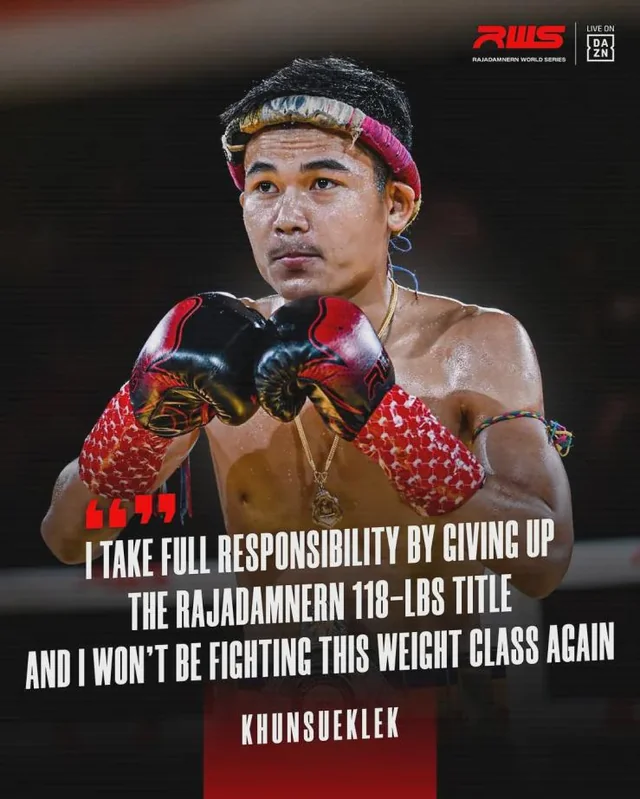
.thumb.jpg.022e299c3d1434f10b770a775a5dade0.jpg)


